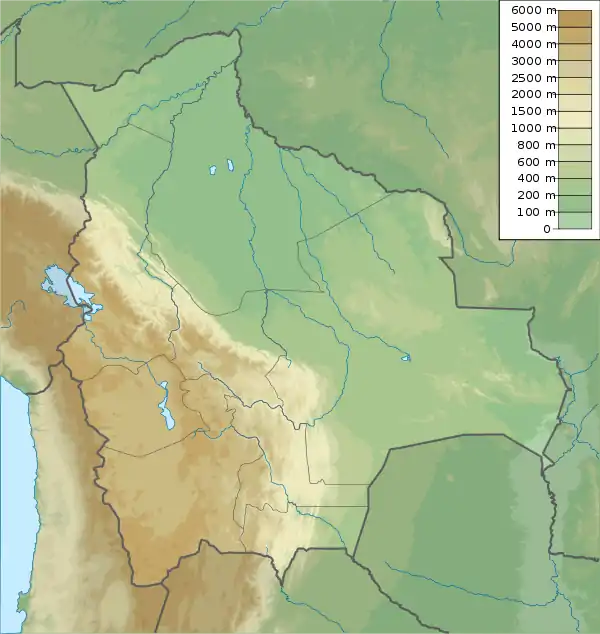Catavi Formation
The Catavi Formation is a Pridoli to Emsian geologic formation of northern and central Bolivia. The formation comprises a 456 m (1,496 ft) thick succession of fine-grained, olive to brown sandstones and siltstones, shales and black limestones deposited in a shallow to deep marine environment.[1][2][3][4][5]
| Catavi Formation | |
|---|---|
| Stratigraphic range: Pridoli-Emsian ~ | |
| Type | Geological formation |
| Overlies | Kirusillas Formation |
| Thickness | Up to 456 m (1,496 ft) |
| Lithology | |
| Primary | Sandstone, siltstone |
| Other | Shale, limestone |
| Location | |
| Coordinates | 17.4°S 66.2°W |
| Approximate paleocoordinates | 56.8°S 112.7°W |
| Region | Cochabamba & La Paz Departments |
| Country | |
| Extent | Cordillera Oriental |
| Type section | |
| Named for | Catavi |
 Catavi Formation (Bolivia) | |
Fossil content
The formation has provided the following fossils:
- Andinodesma radicostata
- Antarctilamna seriponensis
- Australocoelia tourteloti
- Bolivacanthus sagitalis
- Burmeisteria herscheli
- Cingulochitina ceneratiensis, C. ervensis
- Clarkeia antisiensis
- Climatius enodiscosta
- Gomphonchus pluriformis
- Gyracanthus seriponensis
- Kazachstania gerardoi
- Leonaspis (Leonaspis) aracana
- Leonaspis (Leonaspis) berryi
- Leonaspis (? Leonaspis) chacaltayana
- Nodonchus rectus
- Odontochile andii
- Onchus punctuatus, O. sicaeformis
- Paciphacops waisfeldae
- Palaeoneilo unionoides
- Phacopina (Phacopina) chojnacotensis
- Sinacanthus boliviensis
- Turinia gondwana
- Andinacaste cf. legrandi
- Burmeisteria (Digonus) cf. noticus
- Calymene sp.
- Pleurodictyum sp.
- Trimerus sp.
- Acanthodii indet.
- Brachiopoda indet.
- Bryozoa indet.
- Cephalopoda indet.
- Gastropoda indet.
- Ischnacanthida indet.
- Ophiuroidea indet.
- Palaeotaxodonta indet.
- Tentaculitida indet.
- Trilobita indet.
References
- Catavi Unit C3 near Cochabamba at Fossilworks.org
- Catavi vertebrate and mollusc fauna at Seripona at Fossilworks.org
- Catavi Beds, (Phacopina chojnacotensis bed) La Paz Province, Bolivia at Fossilworks.org
- Catavi Unit C1 near Cochabamba at Fossilworks.org
- Trilobite faunule in Catavi unit C2 near Cochabamba at Fossilworks.org
Further reading
- G. D. Edgecombe and L. Ramskold. 1994. Earliest Devonian phacopide trilobites from central Bolivia. Paläontologische Zeitschrift 68(3/4):397-410
- P. Y. Gagnier, S. Turner, L. Friman, M. Suarez-Riglos, and P. Janvier. 1988. The Devonian vertebrate and mollusc fauna from Seripona (Dept. of Chiquisaca, Bolivia). Neues Jahrbuch für Geologie und Paläontologie, Abhandlungen 176(2):269-297
- U. Rehfeld and J. Mehl. 1989. Andinodesma radiata n. gen. n. sp., a grammysiid taxon from the Lower Devonian Catavi-Formation (Bolivia) and its autecological and phylogenetic implications. Paläontologische Zeitschrift 63(3/4):263-279
- Wolfart, R. 1968. Die Trilobiten aus dem Devon Boliviens und ihre Bedeutung fuer Stratigraphie und Tiergeographie. Beihefte zum Geologischen Jahrbuch 74. 5–201. .
This article is issued from Wikipedia. The text is licensed under Creative Commons - Attribution - Sharealike. Additional terms may apply for the media files.